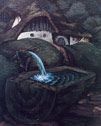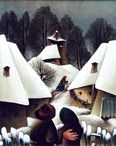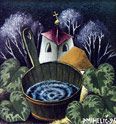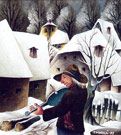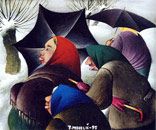We are living in a time when old values are disappearing, when many of us are fruitlessly searching for a good once known as happiness, a time when, in spite of the many acquisitions of modern civilisation, we feel alone, isolated and unhappy. "Life was hard before the war," says Oparnik's mother from Predtrg, "but despite being poor we were happy. As hard and toilsome as the day may have been, the boys always sang in the village in the evenings. Now all of this is a distant memory."
Who would not be more desirous of the former peace and tranquillity of village life than a sensitive painter who grew up in the country and travelled from village to village with his grand-father, selling axle grease. He came to know the local people, their habits and customs, grew to love and cherish them in his memory for always.
Villages of houses with thatched, wooden roofs and windows set into brightly coloured facades are a rarity today. They have disappeared along with countless village symbols - painted votive signs, vividly coloured beehouses, wooden drinking troughs with murmuring water, traditional farm tools, horses and carriages and, what is most regrettable, many old customs and habits. Polde Mihelič revives his youthful images of the village, never forgetting the once lively place it used to be. Village life unwinds in a scene of closely packed stone houses with wooden ridges, steep, snow-covered roofs and small windows set into the walls, sometimes embraced with stacks of firewood, and semi-circular entrances in the middle of facades. A road winds through the village, which is nestled on a slope, to the village church on top, where the scene ends in a mass of trees and a narrow strip of sky. Placed into this imposing and compositionally condensed setting are the inhabitants of the village: country folk clad in old-fashioned clothes, wrapped in wool shawls and covered with brightly coloured scarves - journeymen and women, street vendors, village gossips, couples in love, and even old village codgers crippled from birth, etc. Brought to life before us are Bruegel-like, bustling scenes of the market fair and other traditional village events linked to the seasons. The often intentionally caricatured faces are reminiscent of the figures of Dutch genre painters of the 16th and 17th centuries.
At first glance, Mihelič's paintings resemble Gaspari's folklore paintings. But while Maksim Gaspari is a careful observer and usually a faithful documenter of old village customs and habits, even if in idealized form, Mihelič's approach is entirely personal, introverted. His artistic creativity grows from a nostalgic memory of, in his words, the best years of his life, and the desire to revive and relive the euphoria of youth, that sense of happiness which seems to be constantly slipping away. But when he succeeds in reviving at least a morsel of his past experiences on the painted canvas, he is appeased. This helps us understand why Mihelič was simply not willing to part with some of his works. And if he was forced to sell them, he is buying them back at higher prices. This incessant search for lost happiness, which he believes will save him from the loneliness in his heart, as one of his poems convey, this longing for happiness is one of the main motifs of his painting. And because memory usually changes monotony into colourfulness, poverty into wealth and ordinariness into uniqueness, Mihelič's works are an ideal reflection of his past. His creations seem much too beautiful for the often disorderly village environment, idealized in their presentation of local inhabitants, unrealistic in their vertical composition. Perhaps it is this very high-rising composition that reveals the artist's overpowering, yet never satisfied desire, just as the narrow vertical frames into which the artist occasionally locks his images speak of his sense of confinement, restlessness and fear. These and similar distinctly expressive components of Mihelič's art were already noted by Janez Mesesnel. In some of his paintings, dark skies, "talking trees" and shaded light create a balladlike atmosphere, also felt by Damir Globočnik in his description of Mihelič's art. One of the most characteristic compositions of this type is "Slutnja zla" (Premonition of Evil).
Polde Mihelič has frequently been ranked among naive painters. This has been partly or fully rejected by art critics such as Janez Mesesnel, Aleksander Bassin, Andrej Pavlovec and Damir Globočnik. The artist's forms are reminiscent of naive painters, as he found their formative style most suitable for expressing the conceptual aspects of his art. Being an educated painter, he has established a distance from the spontaneous nature of naive art. The formative deformations so typical of naive art and occasionally present in Mihelič's compositions are not, as already noted by Andrej Pavlovec, the result of deficient painting techniques, but of a conscious and conceptually justified artistic approach.
The paintings of Polde Mihelič are not a more or less faithful record of our folkloristic values, as are the works of Maksim Gaspari, but a consciously naive, simplified and somewhat romantically tinted memory of a happy past that has gradually disappeared along the way, and which the artist wishes to recall in every painting.
Dr. Cene Avguštin
prevod:
Suzana Stančič
|


